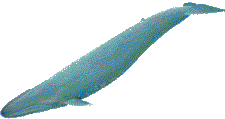The Blue Whale

The blue whale's shape is long and streamlined. It is a member of the family Balaenopteridae which all have fringed baleen plates rather than teeth. blue whales have black-coloured baleen plates. They have grooves or pleats on the throat which extend approximately 60 per cent of the body length, ending beyond the navel. Colour is a slate- or grayish-blue. It is mottled with lighter spots which are concentrated most heavily on the back and shoulders and rarely appear on the head, flippers or flukes. The underside of the flukes is dark, but flippers are sometimes light or even white below and often the tip of the flipper is unpigmented. Blue whales often have a distinctive yellowish-brown film of diatoms which cover or appear on various parts of the body, accounting for the name "sulphur-bottom". The diatom 'infection' forms only after the whales have been in polar regions for a month.
The gestation period is about a year. Calves weigh 2,250 - 2,700 kilograms (2,5 - 3 tons) and measure about 7,3 metres (24 feet) at birth. Feeding on the fat-rich milk of the mother for about eight months, the calf gains about 90 kilograms 9200 pounds) per day until it is weaned. It is then about 15 metres (50 feet) in length. Sexual maturity is achieved somewhere between 23 and 30 years and females appear to breed once every 2 to 3 years.
Blue whales appear to be selective feeders and are virtually monophagous, taking exclusively euphausiids or krill that congregate in dense shoals near the surface. The only exception appears to be off the coast of Baja California where they have been seen feeding on shoals of pelagic crab. They undertake extensive north-south migrations each year, travelling from winter grounds in low latitudes to summer feeding grounds in the Arctic or Antarctic high latitudes. In the Antarctic blue whales and minke whales concentrate while feeding between 60' and 70' south. With regards to their feeding strategies they are categorized as "swallowers", being adapted to feed on dense patches of plankton. The krill sezson lasts for about 120 days after which the icepack covers the feeding grounds and the whales migrate toward the equator. Apparently, during the winter they fast for several months, living off fat reserves built up during the summer feeding season.
The main reason for the decline in blue whale stocks has been commercial whaling; since this whale is now protected from exploitation, it is hoped that the stocks will increase. Pollution, especially oil pollution, is also a limiting factor.

 The Orang Utan
The Orang Utan
 Get your own Free Home Page
Get your own Free Home Page